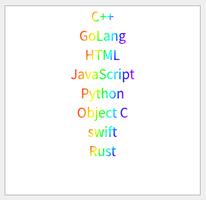如何在将列表中的文字转换为浮点时处理异常?
A=[None, '0.50', '2', '4', '6', '0', '0', '0', '0.00', '0', '0', '0', '5', '1', '5', '5', '1', '1', '0', '1', '2', '2', '2', '0 (1:1)', '0', '0', '2', '2', '0', '0', '1', '2', '0'] B=[]
for elem in A:
if elem is not None:
B.append(float(elem.strip("''")))
else:
B.append(elem)
print B
我有一个列表,其中包含上面显示的值。当我尝试使用熊猫添加到Excel表格时,它将被添加为文本而不是float或int。我想删除引号,以便它不会被视为excel表格中的文本,我知道它可以使用split来完成,如果我尝试将所有这些转换为float,它将引发此'0( 1:1)'元素说无效文字为float。我该如何处理?如何在将列表中的文字转换为浮点时处理异常?
回答:
更简单的解决方案是将包裹for体在try-except和附加None或原始值(elem)如果它没有特定的迭代:
A = [None, '0.50', '2', '4', '6', '0', '0', '0', '0.00', '0', '0', '0', '5', '1', '5', '5', '1', '1', '0', '1', '2', '2', '2', '0 (1:1)', '0', '0', '2', '2', '0', '0', '1', '2', '0'] B = []
for elem in A:
try:
B.append(float(elem))
except (ValueError, TypeError) as error:
B.append(elem)
# Or, if you don't want to preserve the non-numeric values:
# B.append(None)
print(B)
一个ValueError会被抛出时不能解析为float,而elem为None时将丢弃TypeError。
一样,如果使用和ifelem为None和两个异常可以持续进行处理(假设这是你想要的)你不需要检查。
注意不需要.strip("''"),因为它实际上没有做任何事情。 According to the docs, strip() will...:
Return a copy of the string with the leading and trailing characters removed.
也就是说,它会尝试从一开始就和你的价值观的结尾处,删除'',但没有你的价值观的开始或两个单引号结束。实际上,它们中的任何一个都包含引号,它们周围的那些只是表示字符串的方式,但不是它们的价值的一部分。
此外,float()将自动采取Float转换一个数字('1')的字符串表示的护理。
回答:
你可以使用:
def isfloat(element): try:
return float(element)
except ValueError:
return False
B = []
A = [None, '0.50', '2', '4', '6', '0', '0', '0', '0.00', '0', '0', '0', '5', '1', '5', '5', '1', '1', '0', '1', '2', '2', '2', '0 (1:1)', '0', '0', '2', '2', '0', '0', '1', '2', '0']
for x in A:
floatval = isfloat(element)
if floatval:
B.append(floatval)
或者,如果你喜欢一个列表理解(有两个浮筒的冗余):
B = [float(x) for x in A if isfloat(x) not in [False]] 几个陷阱,但:isfloat("NaN"),isfloat("inf"), isfloat(True)将不是返回False。
另一种解决方案使用发电机功能:
def strtofloat(your_list): for i in your_list:
try:
yield float(i)
except (TypeError, ValueError):
pass
B = list(strtofloat(A))
一个更通用的解决方案考虑到多种类型:
def strtofloat(your_list, allowed_types): for i in your_list:
try:
yield f[0](i)
except (TypeError, ValueError):
try:
yield f[1](i)
except (TypeError, ValueError):
pass
B = list(strtofloat(A), [int, float])
如果您传递[float, int],而不是[int, float],它全部有效int s到float s。
回答:
可以使用literal_eval从ast模块,并使用一个try ... except块这样例如:
from ast import literal_eval A=[None, '0.50', '2', '4', '6', '0', '0', '0', '0.00', '0', '0', '0', '5', '1', '5', '5', '1', '1', '0', '1', '2', '2', '2', '0 (1:1)', '0', '0', '2', '2', '0', '0', '1', '2', '0']
def evaluate(a):
for k in a:
try:
# Or if you want: use yield float(k)
yield literal_eval(k)
except ValueError:
yield k
except SyntaxError:
yield k
>>> list(evaluate(A))
[None, 0.5, 2, 4, 6, 0, 0, 0, 0.0, 0, 0, 0, 5, 1, 5, 5, 1, 1, 0, 1, 2, 2, 2, '0(1:1)', 0, 0, 2, 2, 0, 0, 1, 2, 0]
以上是 如何在将列表中的文字转换为浮点时处理异常? 的全部内容, 来源链接: utcz.com/qa/259459.html









